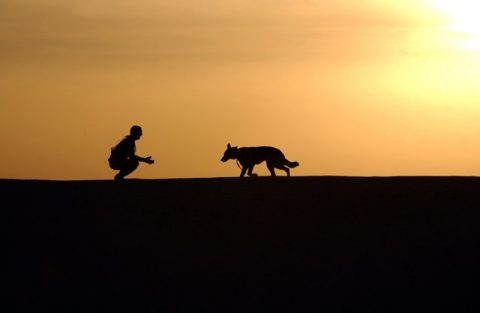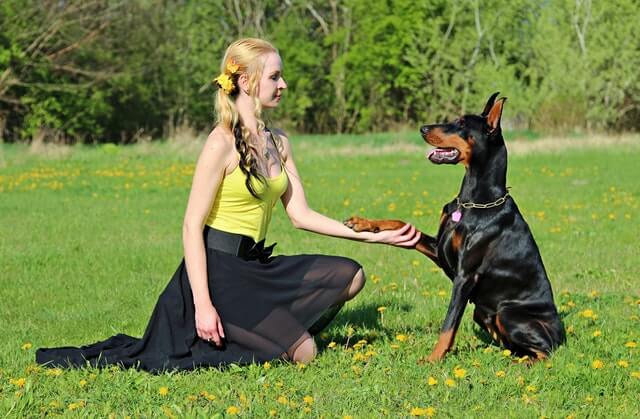Dogs are men’s (or women’s) best friend for a reason. They’ll go wherever we go, do whatever we want to do, all the time, no matter what. As long as they are with us, they’re happy.
Taking a dog on the trail or path with you is one of the most rewarding activities you can do together, and it’s actually much easier than you may realize. Of course, proper training and well-suited breed make a big difference as well.
Curious about turning your dog into a trail dog, or thinking about getting a dog that you can eventually bring along for the ride?
I’ve got you covered.
What is a Trail Dog and Why Do You Need One?
A trailing dog is not any one type of dog but refers to a dog that is trained and acclimated enough to where it can come with you on a ride, whether you’re hitting a single-track trail on a mountain bike, or coasting the paths in your city in a neighborhood or park.
There are several different benefits that both you and your pup can get out of this.

A Rider’s Point of View
Sometimes it’s just fun to have a companion along, right? Your dog already adores you, so bringing it with you on a ride is a good way to spend some quality time together.
Plus, it’s outstanding exercise for your dog, which can help with both their mood and behavior. Dogs that are used to trail riding tend to be much more behaved than other dogs, along with being healthier and happier. This benefits you at home, and ensures a longer, healthier life for your dog — and who doesn’t want that?
Us dog owners know what it’s like to leave the home, trying to avoid eye contact with our dogs because they are mad you’re leaving. If you cycle regularly, this can keep you away from the house for several hours each week.
Bringing your dog along avoids the alone time every dog dreads. And again, it’s just fun to have them around, which also allows you to avoid having to take them for a walk when you get back, or before leaving.
The Dog’s Point of View
Dogs love being outside. Whether it’s some backyard time, a walk around the block, or in your nearby park, dogs love everything about any of it. The sights, the sounds, and of course the smells — it’s all there. It’s stimulating. It’s fun.
They also get to stay by your side, rather than laying on the couch at home, wondering when you’re going to come back through that door.
Sure, your dog loves those neighborhood walks and playing in the backyard, but there’s just something about being able to cover a few miles of trails or paths, where everything is new the whole time. Every trip is different. Always something new to experience. Plus, you know they love being able to run free for a few miles, keeping pace with you.
This gives your dog great exercise and plenty of mental stimulation. And again, it makes them better behaved. You don’t really have an option!
How to Choose Your Trail Dog — 5 Ideal Breeds
There are over 300 dog breeds, so narrowing this down to 5 is a little hard. While these five breeds are definitely ideal and well-suited for being trail dogs, there are plenty of others as well.
For the most part, medium-sized dogs are the best option, especially if they are herding dogs and bird dogs. These dogs have a build and chemistry that is perfect for running long distances while staying cool and being able to breathe properly.
Large dogs like Great Danes definitely are not. The same with bully breeds, or any dogs that are game-oriented and prone to aggression with other animals (or people.) Obviously smaller dogs like Chihuahuas and Boston Terriers are out of the question as well. Their bodies are not made for strenuous exercise, and they are prone to breathing issues already as is.
Okay, onto the best 5.

Australian Cattle Dog
Australian Cattle Dogs are born to run. These reliable, obedient, and highly intelligent herding dogs are very easy to train for trails, and they will absolutely love the exercise each time while behaving very well as they follow you.
Brittany
Brittany’s are avid bird dogs, bred to run long distances for a long period of time during hunts lasting hours. This gives them a body type and genetic temperament that is built for running while having the instinct to always stay with you — or at least come quickly back after doing some investigating.
Pointer
Another example of a hunting dog with a large heart and set of lungs that is entirely conducive to being out in the field all day long. Pointers are very determined, and can easily take on several miles of trail at a time, sometimes making you feel out of shape.
Siberian Husky
Huskies are the quintessential working dogs. Bred to pull sleighs in ridiculous conditions, Siberian Huskies are expert runners that need a ton of exercise. They don’t do well in hot weather; so, keep that in mind.
Weimaraner
Weimaraner’s are the fastest dog on this list, with the nimblest build. If you own one, you know the insane amount of exercise they need, otherwise, they can become quite the handful. If you need a dog that can keep up on the longest and fastest rides, this is it.
How to Cycle with Your Dog
I’m not going to go into a full dissertation on how to bike with your dog, (as that could be an entire series of articles,) but here are some quick pointers.
Before the ride, make sure your dog has had some water, but not too much. Also, make sure they are feeling well, and not acting off.
During the ride, keep a close eye, especially if you’re in busy areas with other people around. In this case, you will need to keep them on a leash when riding, even if they are perfectly behaved, as other dogs might not be. If you’re on a desolate single-track trail, they’re fine off leash.
Always be mindful of weather conditions, and never push them too hard. Dogs will run until they collapse if you let them. After the ride, check your dog over for any stickers or ticks, and be sure to give them a treat for being so good!
Where to Ride a Bike with Your Dog
Parks and your own neighborhood are the best way to start, or even your own backyard if you are trying to get them acclimated at first. Local bike paths and trails are the next steps up, but it’s best to choose ones you’re totally familiar with in every way.
Tips for Cycling with Your Dog
Here are a few helpful tips that can make the ride go well for you, your dog, and anyone else around.
- Cover Your Dog’s Feet – This is often overlooked. There are numerous products available for protecting your dog’s feet, so take advantage, especially if you’re going to be on pavement.
- Take Extra Water and a Treat – Your dog is a mammal like you — it’ll need extra water and food for the longer rides. Don’t forget it.
- Keep Your Dog in Shape – If you don’t take your dog on rides regularly, don’t expect it to automatically be up for a 5-mile single-track trail at any given notice. Keep them running regularly to stay in shape, and tailor your rides to their fitness level.
- Clean Up! – Don’t be that person. Bring extra plastic bags so you can clean up any dog poo they may leave behind.
Always Be Aware of Surroundings – Dogs are animals after all. Keep an eye out for threats and distractions. It’s always best to avoid bad situations, even when they aren’t the ones causing it.



